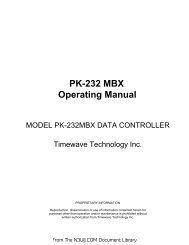DXE-RTR-1 Receive Antenna Interface for Transceivers - N3UJJ
DXE-RTR-1 Receive Antenna Interface for Transceivers - N3UJJ
DXE-RTR-1 Receive Antenna Interface for Transceivers - N3UJJ
- No tags were found...
Create successful ePaper yourself
Turn your PDF publications into a flip-book with our unique Google optimized e-Paper software.
Many owners of transceivers that have receive ports are choosing to use the <strong>DXE</strong>-<strong>RTR</strong>-1. For theseoperators it offers two benefits. First and <strong>for</strong>emost, the <strong>DXE</strong>-<strong>RTR</strong>-1 can protect the front end of thetransceiver with automatic disconnection of the receive input during transmit, preserving fast CWbreak-in operation (QSK) with a 4 ms response time. Second, the <strong>DXE</strong>-<strong>RTR</strong>-1 offers a simple andhandy way to toggle between listening to receive and transmit antennas with a front panel switch.Most high-end transceivers, old and new, offer a receive antenna input that DOES NOT interruptRF or switch off during transmit, even though the receiver is muted, very quickly in full break-inCW operation. This is a design feature which allows an operator to listen to a receive antenna,located a sufficient distance away from the transmit antenna to prevent receiver front end damage,allowing very fast QSK operations. However, most Amateurs who own this type of radio do nothave access to the real estate <strong>for</strong> the required antenna separation to support this type of operation.Un<strong>for</strong>tunately, several hams have discovered these facts the hard way, after unintentionally blowingthe front end of their expensive transceiver with transmitted RF riding in on their receive antennafeedline. Also, on many transceivers, connection of a receive antenna to the RX (antenna) IN portrequires removal of the “RX OUT to RX IN” jumper patch cable, and then the transmit antennacannot be heard. Recommendations <strong>for</strong> external relays and other devices have not addressed theneed <strong>for</strong> protection as well as switching options. The <strong>DXE</strong>-<strong>RTR</strong>-1 fills this need with an attractiveand versatile accessory.For those who want to use a separate receiver or use a second transceiver as a receiver and interruptthe receive antenna feedline when transmitting, the <strong>DXE</strong>-<strong>RTR</strong>-1 may be used as a T/R relay. Also,monitoring the transmitting antenna with a second receiver while operating the main transceiverwith a receive antenna (SO2R application) is possible with the <strong>DXE</strong>-<strong>RTR</strong>-1.The <strong>DXE</strong>-<strong>RTR</strong>-1 may also be used with an optional <strong>DXE</strong>-RSC-2 Two-Port Splitter/Combiner toshare a transmit antenna between two transceivers, with only one used <strong>for</strong> transmitting, or betweena transceiver and a receiver.Standard relays and coaxial relays that are used in a typical default receive T/R system are prone tokeying timing problems which can result in damaging receiver front-ends due to pulses or hotswitching. The <strong>DXE</strong>-<strong>RTR</strong>-1 solves that problem <strong>for</strong> vintage radio collectors and operators. Used asa traditional T/R relay, it switches a transmit antenna between a receiver and a transmitter with anoutput of up to 200 watts. The <strong>DXE</strong>-<strong>RTR</strong>-1 offers complete protection and high speed (4 ms)receive to transmit transfer. The <strong>DXE</strong>-<strong>RTR</strong>-1 is a superior solution to old, slow T/R relays, and itallows the safe use of an optional receive preamplifier.Detailed diagrams of the following applications and accessory connections are included in thismanual.Connecting a transceiver that does not have a receive antenna input to:• <strong>DXE</strong>-ARAV2-1P Active <strong>Receive</strong> <strong>Antenna</strong>• <strong>DXE</strong>-ARAV2-1P Active <strong>Receive</strong> <strong>Antenna</strong> and transmit <strong>Antenna</strong> using high power• <strong>DXE</strong>-NCC-1 <strong>Receive</strong> <strong>Antenna</strong> Variable Phasing Controller with two <strong>DXE</strong>-ARAV2-1PActive <strong>Receive</strong> <strong>Antenna</strong>s• <strong>DXE</strong>-NCC-1 <strong>Receive</strong> <strong>Antenna</strong> Variable Phasing Controller with two <strong>DXE</strong>-ARAV2-1PActive <strong>Receive</strong> antennas using high power to the transmit antenna.• Single transmit antenna system using a <strong>DXE</strong>-RPA-1 Preamplifier• Single transmit antenna system using a <strong>DXE</strong>-RBS-1 Reversible Beverage <strong>Antenna</strong> System5From The <strong>N3UJJ</strong>.COM Document Library
















